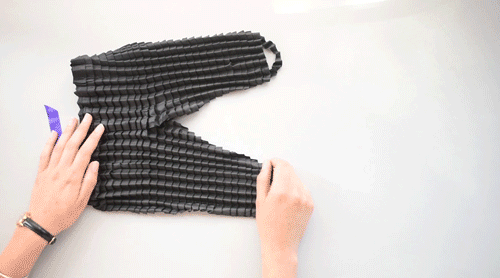UK engineer and designer Ryan Yasin might have perfected ‘childproof’ kids clothing.
The average Australian buys about 13 kg of clothing per year – the second highest per capita consumption of textiles in the world. And for parents of young children (we’re talking newborns to toddlers), making kids clothing last is a real struggle.
It’s no shock that children grow like weeds in those first weeks, months and years of life, but the bill for all those clothes might do the job: most children grow seven sizes in their first two years.
Seeing this firsthand inspired UK engineer and designer Ryan Yasin to create a fabric that stretches as kids do. Yasin, who has a young niece and nephew, combined his interests in fashion design and sustainability to create clothing label Petit Pli, which approaches clothing with a ‘one-size-should-fit-all’ approach.
“My sister just had a baby, and as a present I had bought him some clothes, but by the time I had managed to give them to my sister, the baby had already outgrown them,” he told Smithsonian.
“This was a massive inspiration for me, and I started to think, ‘How can I solve this problem?’.”

Yasin previously studied aeronautical engineering at Imperial College, and currently studies at the Royal College of Art in London. He said his past research into deployable satellite panels for cubesats inspired him to explore folded fabrics for his ‘origami’ kids clothing.
“I started to think about how can clothing be a dynamic object rather than a static one,” he said.
The secret is in the clothing’s pleated design, which allows it to expand in perpendicular directions, allowing it to respond to a child’s body shape as it changes.
He created the first rough prototype of this auxetic material at home – even cooking it in his oven to set the permanent pleats. Its negative Poisson’s ratio means it can expand in different directions at the same time; as the clothing expands lengthwise (say, when a child gets taller) then it will also expand widthwise (for when said child also gains weight).
This innovation won him the UK James Dyson Award earlier this year, which is part of an international competition open to university students and recent graduates studying product design, industrial design and engineering.
The garments look a bit like those bubble shirts from the 90s and early 2000s, but they’re machine washable, durable, rain and windproof, and recyclable to adhere to the line’s sustainability mission. The line currently only includes outerwear, but Yasin said he plans to expand into other styles.
“I have other ideas that I’d love to explore in more depth, and I aim to be a leader in the field of technical garments,” he wrote in his award submission.
He’s now competing against the international finalists to claim the top spot, including against Australia’s own entrant in the Dyson Award.
The worldwide winner was announced in late October, and went to a team of bioengineers from McMaster University in Ontario, Canada for their low-cost, non-invasive melanoma detector.







